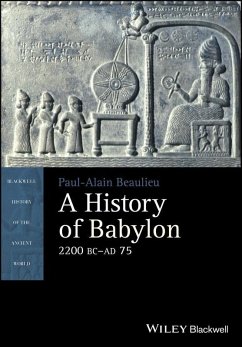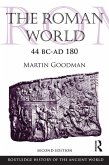Paul-Alain Beaulieu
A History of Babylon, 2200 BC - AD 75 (eBook, PDF)
29,99 €
29,99 €
inkl. MwSt.
Sofort per Download lieferbar

0 °P sammeln
29,99 €
Als Download kaufen

29,99 €
inkl. MwSt.
Sofort per Download lieferbar

0 °P sammeln
Jetzt verschenken
Alle Infos zum eBook verschenken
29,99 €
inkl. MwSt.
Sofort per Download lieferbar
Alle Infos zum eBook verschenken

0 °P sammeln
Paul-Alain Beaulieu
A History of Babylon, 2200 BC - AD 75 (eBook, PDF)
- Format: PDF
- Merkliste
- Auf die Merkliste
- Bewerten Bewerten
- Teilen
- Produkt teilen
- Produkterinnerung
- Produkterinnerung

Bitte loggen Sie sich zunächst in Ihr Kundenkonto ein oder registrieren Sie sich bei
bücher.de, um das eBook-Abo tolino select nutzen zu können.
Hier können Sie sich einloggen
Hier können Sie sich einloggen
Sie sind bereits eingeloggt. Klicken Sie auf 2. tolino select Abo, um fortzufahren.

Bitte loggen Sie sich zunächst in Ihr Kundenkonto ein oder registrieren Sie sich bei bücher.de, um das eBook-Abo tolino select nutzen zu können.
Provides a new narrative history of the ancient world, from the beginnings of civilization in the ancient Near East and Egypt to the fall of Constantinople
Written by an expert in the field, this book presents a narrative history of Babylon from the time of its First Dynasty (1880-1595) until the last centuries of the city's existence during the Hellenistic and Parthian periods (ca. 331-75 AD). Unlike other texts on Ancient Near Eastern and Mesopotamian history, it offers a unique focus on Babylon and Babylonia, while still providing readers with an awareness of the interaction with other…mehr
- Geräte: PC
- mit Kopierschutz
- eBook Hilfe
- Größe: 14.99MB
Andere Kunden interessierten sich auch für
![Aspects of Roman History 31 BC-AD 117 (eBook, PDF) Aspects of Roman History 31 BC-AD 117 (eBook, PDF)]() Richard AlstonAspects of Roman History 31 BC-AD 117 (eBook, PDF)41,95 €
Richard AlstonAspects of Roman History 31 BC-AD 117 (eBook, PDF)41,95 €![Rome and the Western Greeks, 350 BC - AD 200 (eBook, PDF) Rome and the Western Greeks, 350 BC - AD 200 (eBook, PDF)]() Kathryn LomasRome and the Western Greeks, 350 BC - AD 200 (eBook, PDF)55,95 €
Kathryn LomasRome and the Western Greeks, 350 BC - AD 200 (eBook, PDF)55,95 €![Roman Italy, 338 BC - AD 200 (eBook, PDF) Roman Italy, 338 BC - AD 200 (eBook, PDF)]() Kathryn LomasRoman Italy, 338 BC - AD 200 (eBook, PDF)38,95 €
Kathryn LomasRoman Italy, 338 BC - AD 200 (eBook, PDF)38,95 €![The Roman World 44 BC-AD 180 (eBook, PDF) The Roman World 44 BC-AD 180 (eBook, PDF)]() Martin GoodmanThe Roman World 44 BC-AD 180 (eBook, PDF)41,95 €
Martin GoodmanThe Roman World 44 BC-AD 180 (eBook, PDF)41,95 €![The Roman Army, 31 BC - AD 337 (eBook, PDF) The Roman Army, 31 BC - AD 337 (eBook, PDF)]() Brian CampbellThe Roman Army, 31 BC - AD 337 (eBook, PDF)47,95 €
Brian CampbellThe Roman Army, 31 BC - AD 337 (eBook, PDF)47,95 €![Three Ancient Geographical Treatises in Translation (eBook, PDF) Three Ancient Geographical Treatises in Translation (eBook, PDF)]() Duane W. RollerThree Ancient Geographical Treatises in Translation (eBook, PDF)41,95 €
Duane W. RollerThree Ancient Geographical Treatises in Translation (eBook, PDF)41,95 €![A Study of the Circulation of Ceramics in Cyprus from the 3rd Century BC to the 3rd Century AD (eBook, PDF) A Study of the Circulation of Ceramics in Cyprus from the 3rd Century BC to the 3rd Century AD (eBook, PDF)]() John LundA Study of the Circulation of Ceramics in Cyprus from the 3rd Century BC to the 3rd Century AD (eBook, PDF)32,95 €
John LundA Study of the Circulation of Ceramics in Cyprus from the 3rd Century BC to the 3rd Century AD (eBook, PDF)32,95 €-
-
-
Provides a new narrative history of the ancient world, from the beginnings of civilization in the ancient Near East and Egypt to the fall of Constantinople
Written by an expert in the field, this book presents a narrative history of Babylon from the time of its First Dynasty (1880-1595) until the last centuries of the city's existence during the Hellenistic and Parthian periods (ca. 331-75 AD). Unlike other texts on Ancient Near Eastern and Mesopotamian history, it offers a unique focus on Babylon and Babylonia, while still providing readers with an awareness of the interaction with other states and peoples. Organized chronologically, it places the various socio-economic and cultural developments and institutions in their historical context. The book also gives religious and intellectual developments more respectable coverage than books that have come before it.
A History of Babylon, 2200 BC - AD 75 teaches readers about the most important phase in the development of Mesopotamian culture. The book offers in-depth chapter coverage on the Sumero-Addadian Background, the rise of Babylon, the decline of the first dynasty, Kassite ascendancy, the second dynasty of Isin, Arameans and Chaldeans, the Assyrian century, the imperial heyday, and Babylon under foreign rule.
A History of Babylon, 2200 BC - AD 75 is a profound text that will be ideal for upper-level undergraduate and graduate courses on Ancient Near Eastern and Mesopotamian history and scholars of the subject.
Written by an expert in the field, this book presents a narrative history of Babylon from the time of its First Dynasty (1880-1595) until the last centuries of the city's existence during the Hellenistic and Parthian periods (ca. 331-75 AD). Unlike other texts on Ancient Near Eastern and Mesopotamian history, it offers a unique focus on Babylon and Babylonia, while still providing readers with an awareness of the interaction with other states and peoples. Organized chronologically, it places the various socio-economic and cultural developments and institutions in their historical context. The book also gives religious and intellectual developments more respectable coverage than books that have come before it.
A History of Babylon, 2200 BC - AD 75 teaches readers about the most important phase in the development of Mesopotamian culture. The book offers in-depth chapter coverage on the Sumero-Addadian Background, the rise of Babylon, the decline of the first dynasty, Kassite ascendancy, the second dynasty of Isin, Arameans and Chaldeans, the Assyrian century, the imperial heyday, and Babylon under foreign rule.
- Focuses on Babylon and Babylonia
- Written by a highly regarded Assyriologist
- Part of the very successful Histories of the Ancient World series
- An excellent resource for students, instructors, and scholars
A History of Babylon, 2200 BC - AD 75 is a profound text that will be ideal for upper-level undergraduate and graduate courses on Ancient Near Eastern and Mesopotamian history and scholars of the subject.
Dieser Download kann aus rechtlichen Gründen nur mit Rechnungsadresse in D ausgeliefert werden.
Produktdetails
- Produktdetails
- Verlag: John Wiley & Sons
- Erscheinungstermin: 20. November 2017
- Englisch
- ISBN-13: 9781119459071
- Artikelnr.: 50217162
- Verlag: John Wiley & Sons
- Erscheinungstermin: 20. November 2017
- Englisch
- ISBN-13: 9781119459071
- Artikelnr.: 50217162
- Herstellerkennzeichnung Die Herstellerinformationen sind derzeit nicht verfügbar.
Paul-Alain Beaulieu, PhD, is Professor of Assyriology at the University of Toronto. He is the author of several articles and books on the history and culture of Babylonia, as well as the greater spectrum of Mesopotamian history. He has been teaching Assyriology and Ancient Near Eastern History for more than twenty years.
List of Illustrations xii List of Tables xiv List of Maps xvi Preface xvii List of Abbreviations xix Author's Note xx 1 Introductory Concerns 1 1.1 Assyriology and the Writing of History 3 1.1.1 Cuneiform Texts as Historical Sources 4 1.2 Historical Science and the Handling of Sources 17 1.3 Chronology 20 2 The Sumero
Akkadian Background 24 2.1 Babylonia as Geographic Unit 24 2.2 The Natural Environment 25 2.3 The Neolithic Revolution 28 2.4 The Ubaid Period (6500-4000) 29 2.5 The Uruk Period (4000-3100) 30 2.6 The Jemdet Nasr Period (3100-2900) 31 2.7 The Early Dynastic Period (2900-2350) 34 2.7.1 The State of Lagash 38 2.7.2 Babylon in the Early Dynastic Period 40 2.8 The Sargonic (Old Akkadian) and Gutian Periods (ca. 2334-2113) 41 2.8.1 Akkadian and Sumerian Linguistic Areas 42 2.8.2 The Early Sargonic Period (ca. 2334-2255) 44 2.8.3 The Classical Sargonic Period (ca. 2254-2193) 46 2.8.4 Babylon in the Sargonic Period 50 2.8.5 The Late Sargonic (ca. 2193-2154) and Gutian Periods (ca. 2153-2113) 51 2.9 The Third Dynasty of Ur (2112-2004) 52 2.9.1 King of Sumer and Akkad 53 2.9.2 Shulgi's Babylonia 54 2.9.3 Failure of the Ur III State 56 2.9.4 Babylon during the Ur III Period 57 3 The Rise of Babylon 60 3.1 The First Dynasty of Isin (2017-1794) 62 3.2 The Amorites 64 3.2.1 Amorite Genealogies and Histories 66 3.3 Date Lists and King Lists of Babylon I 68 3.4 Elusive Beginnings 69 3.5 Sumu
läel (1880-1845) 70 3.5.1 The Letter of Anam and the Babylon
Uruk Alliance 71 3.6 Half a Century of Stability (1844-1793) 72 3.6.1 The Battle for Kazallu 74 3.6.2 The Apex of Larsa 75 3.7 Hammu
rabi (1792-1750) 76 3.7.1 In the Shadow of Samsi
Addu (1792-1775) 77 3.7.2 Eshnunna's Bid for Hegemony (1772-1770) 79 3.7.3 A Fragile Equilibrium (1769-1766) 80 3.7.4 The Elamite Intervention and its Aftermath (1766-1764) 82 3.7.5 Showdown with Larsa (1764-1763) 83 3.7.6 The Capture and Sack of Mari (1761-1759) 85 3.7.7 Towards an Empire (1759-1750) 85 3.7.8 The Code of Hammu
rabi 86 3.7.9 Hammu
rabi as Administrator 92 4 Decline of the First Dynasty 97 4.1 The Reign of Samsu
iluna (1749-1712) 97 4.1.1 The Rebellion of Rim
Sin II (1742-1740) 99 4.1.2 The Rebellion of Rim
Anum (1742-1740) 100 4.1.3 The Invasion of the Kassites (1742) 101 4.1.4 Samsu
iluna Strikes Back 101 4.1.5 Sargonic Reveries 102 4.1.6 Loss of Southern Babylonia 103 4.1.7 Northern Exertions 104 4.1.8 Loss of Central Babylonia and Rise of the Sealand 108 4.1.9 From Sumerian to Akkadian Literature 108 4.1.10 Samsu
iluna as Administrator and Legislator 109 4.2 The Last Century of Babylon I (1711-1595) 111 4.2.1 Abi
eshuh (1711-1684) 111 4.2.2 Ammi
ditana (1683-1647) 113 4.2.3 Ammi
saduqa (1646-1626) 114 4.2.4 Samsu
ditana (1625-1595) 117 4.2.5 The City of Babylon during the First Dynasty 119 5 Kassite Ascendancy 122 5.1 The Kassites as Linguistic and Cultural Group 122 5.2 The Early Kassite Period (1595-ca. 1400) 125 5.2.1 The Texts from Tell Muhammad 125 5.2.2 The Early Kassite Rulers (Sixteenth Century) 127 5.2.3 The First Dynasty of the Sealand (ca. 1725-1475) 129 5.2.4 The Reunification of Babylonia 131 5.3 Kassite Babylonia: The Documentary Evidence 132 5.3.1 A New Source: The Kudurrus 133 5.4 Karduniash: A New Babylonia 135 5.4.1 Kurigalzu I 137 5.4.2 Dur
Kurigalzu: A Kassite Royal Residence 137 5.5 The Age of Amarna 140 5.6 The Rise of Assyria 142 5.7 The Middle Kassite Period (1332-1225) 143 5.7.1 Ruralization of Babylonia 145 5.7.2 Nippur as Southern Capital 146 5.8 The Intervention of Tukulti
Ninurta I and its Aftermath 147 5.9 End of the Kassite Regime (1186-1155) 150 5.10 Akkadian Literature under the Kassites 151 6 Second Dynasty of Isin 154 6.1 Marduk and Nabu 157 6.2 Renewed Conflict with Assyria 158 6.3 Nebuchadnezzar I (1121-1100) 159 6.3.1 The Elamite Campaign and the Return of Marduk 159 6.3.2 Enuma Elish and the Supremacy of Marduk 161 6.3.3 Nebuchadnezzar I and Royal Legitimacy 163 6.4 Sealand Memories under Enlil
nadin
apli (1099-1096) 164 6.5 Marduk
nadin
ahhe (1095-1078) 164 6.5.1 Aramean Invasions 167 6.6 Marduk
shapik
zeri (1077-1065) 167 6.7 Adad
apläiddina (1064-1043) 168 6.8 The End of Isin II (1042-1022) 169 7 Arameans and Chaldeans 171 7.1 The Arameans 172 7.2 The Chaldeans 173 7.3 Three Short Dynasties 176 7.4 The Dynasty of E 178 7.4.1 Nabu
mukin
apli (974-939) 179 7.4.2 Assyrian Resurgence 179 7.4.3 Nabu
apläiddina 180 7.4.4 Marduk
zakir
shumi I 182 7.4.5 Descent into Anarchy (819-770?) 183 7.4.6 EribäMarduk 186 7.4.7 Nabu
shumäishkun (760?-748) 186 7.4.8 Nabonassar (747-734) 188 8 The Assyrian Century 193 8.1 The Rebellion of Mukin
zeri 196 8.2 The palû of Baltil (728-722) 197 8.3 Marduk
apläiddina II and Chaldean Resistance (721-709) 198 8.4 The palû of Habigal (709-694) 201 8.5 The Two Shuzubus (694-689) 204 8.6 Sennacherib's Desecration of Babylon (689-681) 206 8.7 Esarhaddon Restores Babylon (681-669) 208 8.7.1 A New Generation of Opponents 209 8.8 Regnant Siblings (669-652) 211 8.9 Civil War (652-648) 214 8.10 Ashurbanipal and Kandalanu (647-630/27) 216 9 Imperial Heyday 219 9.1 Sources 220 9.1.1 Neo
Babylonian Archives 221 9.1.2 Spread of Aramaic 222 9.2 Power Struggle for Babylonia (630-620) 223 9.3 A Chaldeo
Aramean Empire 224 9.4 The Fall of Assyria (616-609) 225 9.5 Nabopolassar and the Restoration of Babylonia 227 9.6 Nebuchadnezzar in the Levant 227 9.7 The Climax of Babylon 229 9.7.1 Economic Expansion 232 9.7.2 Administration of Babylonia 233 9.7.3 Methods of Imperial Control 235 9.8 A Problematic Succession (562-556) 237 9.9 Babylon's Twilight: The Reign of Nabonidus (555-539) 238 9.9.1 The Conquest of North Arabia 239 9.9.2 Geopolitical Upheaval 240 9.9.3 The Last Days of Imperial Babylon 243 10 Babylon under Foreign Rule 246 10.1 Cyrus Enters Babylon 247 10.2 A Smooth Transition 248 10.3 The Babylonian Pretenders of 522-521 250 10.4 The Reforms of Darius I 251 10.5 The Babylonian Pretenders of 484 253 10.6 Babylonia in the Late Achaemenid Period 254 10.7 Hellenistic Babylonia 256 10.8 Alexander and his Successors in Babylon (331-311) 257 10.9 Babylon and Seleucia 259 10.10 An Age of Renewal 261 10.11 Hellenization of Babylonia 263 10.12 Parthian Takeover 265 10.13 Sic Transit 266 Appendix: Checklist of Chronicles 269 Bibliography 271 Index 273
Akkadian Background 24 2.1 Babylonia as Geographic Unit 24 2.2 The Natural Environment 25 2.3 The Neolithic Revolution 28 2.4 The Ubaid Period (6500-4000) 29 2.5 The Uruk Period (4000-3100) 30 2.6 The Jemdet Nasr Period (3100-2900) 31 2.7 The Early Dynastic Period (2900-2350) 34 2.7.1 The State of Lagash 38 2.7.2 Babylon in the Early Dynastic Period 40 2.8 The Sargonic (Old Akkadian) and Gutian Periods (ca. 2334-2113) 41 2.8.1 Akkadian and Sumerian Linguistic Areas 42 2.8.2 The Early Sargonic Period (ca. 2334-2255) 44 2.8.3 The Classical Sargonic Period (ca. 2254-2193) 46 2.8.4 Babylon in the Sargonic Period 50 2.8.5 The Late Sargonic (ca. 2193-2154) and Gutian Periods (ca. 2153-2113) 51 2.9 The Third Dynasty of Ur (2112-2004) 52 2.9.1 King of Sumer and Akkad 53 2.9.2 Shulgi's Babylonia 54 2.9.3 Failure of the Ur III State 56 2.9.4 Babylon during the Ur III Period 57 3 The Rise of Babylon 60 3.1 The First Dynasty of Isin (2017-1794) 62 3.2 The Amorites 64 3.2.1 Amorite Genealogies and Histories 66 3.3 Date Lists and King Lists of Babylon I 68 3.4 Elusive Beginnings 69 3.5 Sumu
läel (1880-1845) 70 3.5.1 The Letter of Anam and the Babylon
Uruk Alliance 71 3.6 Half a Century of Stability (1844-1793) 72 3.6.1 The Battle for Kazallu 74 3.6.2 The Apex of Larsa 75 3.7 Hammu
rabi (1792-1750) 76 3.7.1 In the Shadow of Samsi
Addu (1792-1775) 77 3.7.2 Eshnunna's Bid for Hegemony (1772-1770) 79 3.7.3 A Fragile Equilibrium (1769-1766) 80 3.7.4 The Elamite Intervention and its Aftermath (1766-1764) 82 3.7.5 Showdown with Larsa (1764-1763) 83 3.7.6 The Capture and Sack of Mari (1761-1759) 85 3.7.7 Towards an Empire (1759-1750) 85 3.7.8 The Code of Hammu
rabi 86 3.7.9 Hammu
rabi as Administrator 92 4 Decline of the First Dynasty 97 4.1 The Reign of Samsu
iluna (1749-1712) 97 4.1.1 The Rebellion of Rim
Sin II (1742-1740) 99 4.1.2 The Rebellion of Rim
Anum (1742-1740) 100 4.1.3 The Invasion of the Kassites (1742) 101 4.1.4 Samsu
iluna Strikes Back 101 4.1.5 Sargonic Reveries 102 4.1.6 Loss of Southern Babylonia 103 4.1.7 Northern Exertions 104 4.1.8 Loss of Central Babylonia and Rise of the Sealand 108 4.1.9 From Sumerian to Akkadian Literature 108 4.1.10 Samsu
iluna as Administrator and Legislator 109 4.2 The Last Century of Babylon I (1711-1595) 111 4.2.1 Abi
eshuh (1711-1684) 111 4.2.2 Ammi
ditana (1683-1647) 113 4.2.3 Ammi
saduqa (1646-1626) 114 4.2.4 Samsu
ditana (1625-1595) 117 4.2.5 The City of Babylon during the First Dynasty 119 5 Kassite Ascendancy 122 5.1 The Kassites as Linguistic and Cultural Group 122 5.2 The Early Kassite Period (1595-ca. 1400) 125 5.2.1 The Texts from Tell Muhammad 125 5.2.2 The Early Kassite Rulers (Sixteenth Century) 127 5.2.3 The First Dynasty of the Sealand (ca. 1725-1475) 129 5.2.4 The Reunification of Babylonia 131 5.3 Kassite Babylonia: The Documentary Evidence 132 5.3.1 A New Source: The Kudurrus 133 5.4 Karduniash: A New Babylonia 135 5.4.1 Kurigalzu I 137 5.4.2 Dur
Kurigalzu: A Kassite Royal Residence 137 5.5 The Age of Amarna 140 5.6 The Rise of Assyria 142 5.7 The Middle Kassite Period (1332-1225) 143 5.7.1 Ruralization of Babylonia 145 5.7.2 Nippur as Southern Capital 146 5.8 The Intervention of Tukulti
Ninurta I and its Aftermath 147 5.9 End of the Kassite Regime (1186-1155) 150 5.10 Akkadian Literature under the Kassites 151 6 Second Dynasty of Isin 154 6.1 Marduk and Nabu 157 6.2 Renewed Conflict with Assyria 158 6.3 Nebuchadnezzar I (1121-1100) 159 6.3.1 The Elamite Campaign and the Return of Marduk 159 6.3.2 Enuma Elish and the Supremacy of Marduk 161 6.3.3 Nebuchadnezzar I and Royal Legitimacy 163 6.4 Sealand Memories under Enlil
nadin
apli (1099-1096) 164 6.5 Marduk
nadin
ahhe (1095-1078) 164 6.5.1 Aramean Invasions 167 6.6 Marduk
shapik
zeri (1077-1065) 167 6.7 Adad
apläiddina (1064-1043) 168 6.8 The End of Isin II (1042-1022) 169 7 Arameans and Chaldeans 171 7.1 The Arameans 172 7.2 The Chaldeans 173 7.3 Three Short Dynasties 176 7.4 The Dynasty of E 178 7.4.1 Nabu
mukin
apli (974-939) 179 7.4.2 Assyrian Resurgence 179 7.4.3 Nabu
apläiddina 180 7.4.4 Marduk
zakir
shumi I 182 7.4.5 Descent into Anarchy (819-770?) 183 7.4.6 EribäMarduk 186 7.4.7 Nabu
shumäishkun (760?-748) 186 7.4.8 Nabonassar (747-734) 188 8 The Assyrian Century 193 8.1 The Rebellion of Mukin
zeri 196 8.2 The palû of Baltil (728-722) 197 8.3 Marduk
apläiddina II and Chaldean Resistance (721-709) 198 8.4 The palû of Habigal (709-694) 201 8.5 The Two Shuzubus (694-689) 204 8.6 Sennacherib's Desecration of Babylon (689-681) 206 8.7 Esarhaddon Restores Babylon (681-669) 208 8.7.1 A New Generation of Opponents 209 8.8 Regnant Siblings (669-652) 211 8.9 Civil War (652-648) 214 8.10 Ashurbanipal and Kandalanu (647-630/27) 216 9 Imperial Heyday 219 9.1 Sources 220 9.1.1 Neo
Babylonian Archives 221 9.1.2 Spread of Aramaic 222 9.2 Power Struggle for Babylonia (630-620) 223 9.3 A Chaldeo
Aramean Empire 224 9.4 The Fall of Assyria (616-609) 225 9.5 Nabopolassar and the Restoration of Babylonia 227 9.6 Nebuchadnezzar in the Levant 227 9.7 The Climax of Babylon 229 9.7.1 Economic Expansion 232 9.7.2 Administration of Babylonia 233 9.7.3 Methods of Imperial Control 235 9.8 A Problematic Succession (562-556) 237 9.9 Babylon's Twilight: The Reign of Nabonidus (555-539) 238 9.9.1 The Conquest of North Arabia 239 9.9.2 Geopolitical Upheaval 240 9.9.3 The Last Days of Imperial Babylon 243 10 Babylon under Foreign Rule 246 10.1 Cyrus Enters Babylon 247 10.2 A Smooth Transition 248 10.3 The Babylonian Pretenders of 522-521 250 10.4 The Reforms of Darius I 251 10.5 The Babylonian Pretenders of 484 253 10.6 Babylonia in the Late Achaemenid Period 254 10.7 Hellenistic Babylonia 256 10.8 Alexander and his Successors in Babylon (331-311) 257 10.9 Babylon and Seleucia 259 10.10 An Age of Renewal 261 10.11 Hellenization of Babylonia 263 10.12 Parthian Takeover 265 10.13 Sic Transit 266 Appendix: Checklist of Chronicles 269 Bibliography 271 Index 273
List of Illustrations xii List of Tables xiv List of Maps xvi Preface xvii List of Abbreviations xix Author's Note xx 1 Introductory Concerns 1 1.1 Assyriology and the Writing of History 3 1.1.1 Cuneiform Texts as Historical Sources 4 1.2 Historical Science and the Handling of Sources 17 1.3 Chronology 20 2 The Sumero
Akkadian Background 24 2.1 Babylonia as Geographic Unit 24 2.2 The Natural Environment 25 2.3 The Neolithic Revolution 28 2.4 The Ubaid Period (6500-4000) 29 2.5 The Uruk Period (4000-3100) 30 2.6 The Jemdet Nasr Period (3100-2900) 31 2.7 The Early Dynastic Period (2900-2350) 34 2.7.1 The State of Lagash 38 2.7.2 Babylon in the Early Dynastic Period 40 2.8 The Sargonic (Old Akkadian) and Gutian Periods (ca. 2334-2113) 41 2.8.1 Akkadian and Sumerian Linguistic Areas 42 2.8.2 The Early Sargonic Period (ca. 2334-2255) 44 2.8.3 The Classical Sargonic Period (ca. 2254-2193) 46 2.8.4 Babylon in the Sargonic Period 50 2.8.5 The Late Sargonic (ca. 2193-2154) and Gutian Periods (ca. 2153-2113) 51 2.9 The Third Dynasty of Ur (2112-2004) 52 2.9.1 King of Sumer and Akkad 53 2.9.2 Shulgi's Babylonia 54 2.9.3 Failure of the Ur III State 56 2.9.4 Babylon during the Ur III Period 57 3 The Rise of Babylon 60 3.1 The First Dynasty of Isin (2017-1794) 62 3.2 The Amorites 64 3.2.1 Amorite Genealogies and Histories 66 3.3 Date Lists and King Lists of Babylon I 68 3.4 Elusive Beginnings 69 3.5 Sumu
läel (1880-1845) 70 3.5.1 The Letter of Anam and the Babylon
Uruk Alliance 71 3.6 Half a Century of Stability (1844-1793) 72 3.6.1 The Battle for Kazallu 74 3.6.2 The Apex of Larsa 75 3.7 Hammu
rabi (1792-1750) 76 3.7.1 In the Shadow of Samsi
Addu (1792-1775) 77 3.7.2 Eshnunna's Bid for Hegemony (1772-1770) 79 3.7.3 A Fragile Equilibrium (1769-1766) 80 3.7.4 The Elamite Intervention and its Aftermath (1766-1764) 82 3.7.5 Showdown with Larsa (1764-1763) 83 3.7.6 The Capture and Sack of Mari (1761-1759) 85 3.7.7 Towards an Empire (1759-1750) 85 3.7.8 The Code of Hammu
rabi 86 3.7.9 Hammu
rabi as Administrator 92 4 Decline of the First Dynasty 97 4.1 The Reign of Samsu
iluna (1749-1712) 97 4.1.1 The Rebellion of Rim
Sin II (1742-1740) 99 4.1.2 The Rebellion of Rim
Anum (1742-1740) 100 4.1.3 The Invasion of the Kassites (1742) 101 4.1.4 Samsu
iluna Strikes Back 101 4.1.5 Sargonic Reveries 102 4.1.6 Loss of Southern Babylonia 103 4.1.7 Northern Exertions 104 4.1.8 Loss of Central Babylonia and Rise of the Sealand 108 4.1.9 From Sumerian to Akkadian Literature 108 4.1.10 Samsu
iluna as Administrator and Legislator 109 4.2 The Last Century of Babylon I (1711-1595) 111 4.2.1 Abi
eshuh (1711-1684) 111 4.2.2 Ammi
ditana (1683-1647) 113 4.2.3 Ammi
saduqa (1646-1626) 114 4.2.4 Samsu
ditana (1625-1595) 117 4.2.5 The City of Babylon during the First Dynasty 119 5 Kassite Ascendancy 122 5.1 The Kassites as Linguistic and Cultural Group 122 5.2 The Early Kassite Period (1595-ca. 1400) 125 5.2.1 The Texts from Tell Muhammad 125 5.2.2 The Early Kassite Rulers (Sixteenth Century) 127 5.2.3 The First Dynasty of the Sealand (ca. 1725-1475) 129 5.2.4 The Reunification of Babylonia 131 5.3 Kassite Babylonia: The Documentary Evidence 132 5.3.1 A New Source: The Kudurrus 133 5.4 Karduniash: A New Babylonia 135 5.4.1 Kurigalzu I 137 5.4.2 Dur
Kurigalzu: A Kassite Royal Residence 137 5.5 The Age of Amarna 140 5.6 The Rise of Assyria 142 5.7 The Middle Kassite Period (1332-1225) 143 5.7.1 Ruralization of Babylonia 145 5.7.2 Nippur as Southern Capital 146 5.8 The Intervention of Tukulti
Ninurta I and its Aftermath 147 5.9 End of the Kassite Regime (1186-1155) 150 5.10 Akkadian Literature under the Kassites 151 6 Second Dynasty of Isin 154 6.1 Marduk and Nabu 157 6.2 Renewed Conflict with Assyria 158 6.3 Nebuchadnezzar I (1121-1100) 159 6.3.1 The Elamite Campaign and the Return of Marduk 159 6.3.2 Enuma Elish and the Supremacy of Marduk 161 6.3.3 Nebuchadnezzar I and Royal Legitimacy 163 6.4 Sealand Memories under Enlil
nadin
apli (1099-1096) 164 6.5 Marduk
nadin
ahhe (1095-1078) 164 6.5.1 Aramean Invasions 167 6.6 Marduk
shapik
zeri (1077-1065) 167 6.7 Adad
apläiddina (1064-1043) 168 6.8 The End of Isin II (1042-1022) 169 7 Arameans and Chaldeans 171 7.1 The Arameans 172 7.2 The Chaldeans 173 7.3 Three Short Dynasties 176 7.4 The Dynasty of E 178 7.4.1 Nabu
mukin
apli (974-939) 179 7.4.2 Assyrian Resurgence 179 7.4.3 Nabu
apläiddina 180 7.4.4 Marduk
zakir
shumi I 182 7.4.5 Descent into Anarchy (819-770?) 183 7.4.6 EribäMarduk 186 7.4.7 Nabu
shumäishkun (760?-748) 186 7.4.8 Nabonassar (747-734) 188 8 The Assyrian Century 193 8.1 The Rebellion of Mukin
zeri 196 8.2 The palû of Baltil (728-722) 197 8.3 Marduk
apläiddina II and Chaldean Resistance (721-709) 198 8.4 The palû of Habigal (709-694) 201 8.5 The Two Shuzubus (694-689) 204 8.6 Sennacherib's Desecration of Babylon (689-681) 206 8.7 Esarhaddon Restores Babylon (681-669) 208 8.7.1 A New Generation of Opponents 209 8.8 Regnant Siblings (669-652) 211 8.9 Civil War (652-648) 214 8.10 Ashurbanipal and Kandalanu (647-630/27) 216 9 Imperial Heyday 219 9.1 Sources 220 9.1.1 Neo
Babylonian Archives 221 9.1.2 Spread of Aramaic 222 9.2 Power Struggle for Babylonia (630-620) 223 9.3 A Chaldeo
Aramean Empire 224 9.4 The Fall of Assyria (616-609) 225 9.5 Nabopolassar and the Restoration of Babylonia 227 9.6 Nebuchadnezzar in the Levant 227 9.7 The Climax of Babylon 229 9.7.1 Economic Expansion 232 9.7.2 Administration of Babylonia 233 9.7.3 Methods of Imperial Control 235 9.8 A Problematic Succession (562-556) 237 9.9 Babylon's Twilight: The Reign of Nabonidus (555-539) 238 9.9.1 The Conquest of North Arabia 239 9.9.2 Geopolitical Upheaval 240 9.9.3 The Last Days of Imperial Babylon 243 10 Babylon under Foreign Rule 246 10.1 Cyrus Enters Babylon 247 10.2 A Smooth Transition 248 10.3 The Babylonian Pretenders of 522-521 250 10.4 The Reforms of Darius I 251 10.5 The Babylonian Pretenders of 484 253 10.6 Babylonia in the Late Achaemenid Period 254 10.7 Hellenistic Babylonia 256 10.8 Alexander and his Successors in Babylon (331-311) 257 10.9 Babylon and Seleucia 259 10.10 An Age of Renewal 261 10.11 Hellenization of Babylonia 263 10.12 Parthian Takeover 265 10.13 Sic Transit 266 Appendix: Checklist of Chronicles 269 Bibliography 271 Index 273
Akkadian Background 24 2.1 Babylonia as Geographic Unit 24 2.2 The Natural Environment 25 2.3 The Neolithic Revolution 28 2.4 The Ubaid Period (6500-4000) 29 2.5 The Uruk Period (4000-3100) 30 2.6 The Jemdet Nasr Period (3100-2900) 31 2.7 The Early Dynastic Period (2900-2350) 34 2.7.1 The State of Lagash 38 2.7.2 Babylon in the Early Dynastic Period 40 2.8 The Sargonic (Old Akkadian) and Gutian Periods (ca. 2334-2113) 41 2.8.1 Akkadian and Sumerian Linguistic Areas 42 2.8.2 The Early Sargonic Period (ca. 2334-2255) 44 2.8.3 The Classical Sargonic Period (ca. 2254-2193) 46 2.8.4 Babylon in the Sargonic Period 50 2.8.5 The Late Sargonic (ca. 2193-2154) and Gutian Periods (ca. 2153-2113) 51 2.9 The Third Dynasty of Ur (2112-2004) 52 2.9.1 King of Sumer and Akkad 53 2.9.2 Shulgi's Babylonia 54 2.9.3 Failure of the Ur III State 56 2.9.4 Babylon during the Ur III Period 57 3 The Rise of Babylon 60 3.1 The First Dynasty of Isin (2017-1794) 62 3.2 The Amorites 64 3.2.1 Amorite Genealogies and Histories 66 3.3 Date Lists and King Lists of Babylon I 68 3.4 Elusive Beginnings 69 3.5 Sumu
läel (1880-1845) 70 3.5.1 The Letter of Anam and the Babylon
Uruk Alliance 71 3.6 Half a Century of Stability (1844-1793) 72 3.6.1 The Battle for Kazallu 74 3.6.2 The Apex of Larsa 75 3.7 Hammu
rabi (1792-1750) 76 3.7.1 In the Shadow of Samsi
Addu (1792-1775) 77 3.7.2 Eshnunna's Bid for Hegemony (1772-1770) 79 3.7.3 A Fragile Equilibrium (1769-1766) 80 3.7.4 The Elamite Intervention and its Aftermath (1766-1764) 82 3.7.5 Showdown with Larsa (1764-1763) 83 3.7.6 The Capture and Sack of Mari (1761-1759) 85 3.7.7 Towards an Empire (1759-1750) 85 3.7.8 The Code of Hammu
rabi 86 3.7.9 Hammu
rabi as Administrator 92 4 Decline of the First Dynasty 97 4.1 The Reign of Samsu
iluna (1749-1712) 97 4.1.1 The Rebellion of Rim
Sin II (1742-1740) 99 4.1.2 The Rebellion of Rim
Anum (1742-1740) 100 4.1.3 The Invasion of the Kassites (1742) 101 4.1.4 Samsu
iluna Strikes Back 101 4.1.5 Sargonic Reveries 102 4.1.6 Loss of Southern Babylonia 103 4.1.7 Northern Exertions 104 4.1.8 Loss of Central Babylonia and Rise of the Sealand 108 4.1.9 From Sumerian to Akkadian Literature 108 4.1.10 Samsu
iluna as Administrator and Legislator 109 4.2 The Last Century of Babylon I (1711-1595) 111 4.2.1 Abi
eshuh (1711-1684) 111 4.2.2 Ammi
ditana (1683-1647) 113 4.2.3 Ammi
saduqa (1646-1626) 114 4.2.4 Samsu
ditana (1625-1595) 117 4.2.5 The City of Babylon during the First Dynasty 119 5 Kassite Ascendancy 122 5.1 The Kassites as Linguistic and Cultural Group 122 5.2 The Early Kassite Period (1595-ca. 1400) 125 5.2.1 The Texts from Tell Muhammad 125 5.2.2 The Early Kassite Rulers (Sixteenth Century) 127 5.2.3 The First Dynasty of the Sealand (ca. 1725-1475) 129 5.2.4 The Reunification of Babylonia 131 5.3 Kassite Babylonia: The Documentary Evidence 132 5.3.1 A New Source: The Kudurrus 133 5.4 Karduniash: A New Babylonia 135 5.4.1 Kurigalzu I 137 5.4.2 Dur
Kurigalzu: A Kassite Royal Residence 137 5.5 The Age of Amarna 140 5.6 The Rise of Assyria 142 5.7 The Middle Kassite Period (1332-1225) 143 5.7.1 Ruralization of Babylonia 145 5.7.2 Nippur as Southern Capital 146 5.8 The Intervention of Tukulti
Ninurta I and its Aftermath 147 5.9 End of the Kassite Regime (1186-1155) 150 5.10 Akkadian Literature under the Kassites 151 6 Second Dynasty of Isin 154 6.1 Marduk and Nabu 157 6.2 Renewed Conflict with Assyria 158 6.3 Nebuchadnezzar I (1121-1100) 159 6.3.1 The Elamite Campaign and the Return of Marduk 159 6.3.2 Enuma Elish and the Supremacy of Marduk 161 6.3.3 Nebuchadnezzar I and Royal Legitimacy 163 6.4 Sealand Memories under Enlil
nadin
apli (1099-1096) 164 6.5 Marduk
nadin
ahhe (1095-1078) 164 6.5.1 Aramean Invasions 167 6.6 Marduk
shapik
zeri (1077-1065) 167 6.7 Adad
apläiddina (1064-1043) 168 6.8 The End of Isin II (1042-1022) 169 7 Arameans and Chaldeans 171 7.1 The Arameans 172 7.2 The Chaldeans 173 7.3 Three Short Dynasties 176 7.4 The Dynasty of E 178 7.4.1 Nabu
mukin
apli (974-939) 179 7.4.2 Assyrian Resurgence 179 7.4.3 Nabu
apläiddina 180 7.4.4 Marduk
zakir
shumi I 182 7.4.5 Descent into Anarchy (819-770?) 183 7.4.6 EribäMarduk 186 7.4.7 Nabu
shumäishkun (760?-748) 186 7.4.8 Nabonassar (747-734) 188 8 The Assyrian Century 193 8.1 The Rebellion of Mukin
zeri 196 8.2 The palû of Baltil (728-722) 197 8.3 Marduk
apläiddina II and Chaldean Resistance (721-709) 198 8.4 The palû of Habigal (709-694) 201 8.5 The Two Shuzubus (694-689) 204 8.6 Sennacherib's Desecration of Babylon (689-681) 206 8.7 Esarhaddon Restores Babylon (681-669) 208 8.7.1 A New Generation of Opponents 209 8.8 Regnant Siblings (669-652) 211 8.9 Civil War (652-648) 214 8.10 Ashurbanipal and Kandalanu (647-630/27) 216 9 Imperial Heyday 219 9.1 Sources 220 9.1.1 Neo
Babylonian Archives 221 9.1.2 Spread of Aramaic 222 9.2 Power Struggle for Babylonia (630-620) 223 9.3 A Chaldeo
Aramean Empire 224 9.4 The Fall of Assyria (616-609) 225 9.5 Nabopolassar and the Restoration of Babylonia 227 9.6 Nebuchadnezzar in the Levant 227 9.7 The Climax of Babylon 229 9.7.1 Economic Expansion 232 9.7.2 Administration of Babylonia 233 9.7.3 Methods of Imperial Control 235 9.8 A Problematic Succession (562-556) 237 9.9 Babylon's Twilight: The Reign of Nabonidus (555-539) 238 9.9.1 The Conquest of North Arabia 239 9.9.2 Geopolitical Upheaval 240 9.9.3 The Last Days of Imperial Babylon 243 10 Babylon under Foreign Rule 246 10.1 Cyrus Enters Babylon 247 10.2 A Smooth Transition 248 10.3 The Babylonian Pretenders of 522-521 250 10.4 The Reforms of Darius I 251 10.5 The Babylonian Pretenders of 484 253 10.6 Babylonia in the Late Achaemenid Period 254 10.7 Hellenistic Babylonia 256 10.8 Alexander and his Successors in Babylon (331-311) 257 10.9 Babylon and Seleucia 259 10.10 An Age of Renewal 261 10.11 Hellenization of Babylonia 263 10.12 Parthian Takeover 265 10.13 Sic Transit 266 Appendix: Checklist of Chronicles 269 Bibliography 271 Index 273







